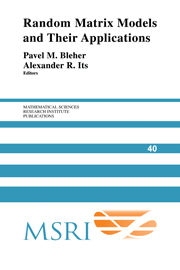Book contents
- Frontmatter
- Contents
- Preface
- Symmetrized Random Permutations
- Hankel Determinants as Fredholm Determinants
- Universality and Scaling of Zeros on Symplectic Manifolds
- z-Measures on Partitions, Robinson-Schensted-Knuth Correspondence, and β = 2 Random Matrix Ensembles
- Phase Transitions and Random Matrices
- Matrix Model Combinatorics: Applications to Folding and Coloring
- Interrelationships Between Orthogonal, Unitary and Symplectic Matrix Ensembles
- Dual Isomonodromic Tau Functions and Determinants of Integrable Fredholm Operators
- Functional Equations and Electrostatic Models for Orthogonal Polynomials
- Random Words, Toeplitz Determinants, and Integrable Systems I
- Random Permutations and the Discrete Bessel Kernel
- Solvable Matrix Models
- The τ-Function for Analytic Curves
- Integration over Angular Variables for Two Coupled Matrices
- Integrable Lattices: Random Matrices and Random Permutations
- SL(2) and z-Measures
- Some Matrix Integrals Related to Knots and Links
Interrelationships Between Orthogonal, Unitary and Symplectic Matrix Ensembles
Published online by Cambridge University Press: 25 June 2025
- Frontmatter
- Contents
- Preface
- Symmetrized Random Permutations
- Hankel Determinants as Fredholm Determinants
- Universality and Scaling of Zeros on Symplectic Manifolds
- z-Measures on Partitions, Robinson-Schensted-Knuth Correspondence, and β = 2 Random Matrix Ensembles
- Phase Transitions and Random Matrices
- Matrix Model Combinatorics: Applications to Folding and Coloring
- Interrelationships Between Orthogonal, Unitary and Symplectic Matrix Ensembles
- Dual Isomonodromic Tau Functions and Determinants of Integrable Fredholm Operators
- Functional Equations and Electrostatic Models for Orthogonal Polynomials
- Random Words, Toeplitz Determinants, and Integrable Systems I
- Random Permutations and the Discrete Bessel Kernel
- Solvable Matrix Models
- The τ-Function for Analytic Curves
- Integration over Angular Variables for Two Coupled Matrices
- Integrable Lattices: Random Matrices and Random Permutations
- SL(2) and z-Measures
- Some Matrix Integrals Related to Knots and Links
Summary
We consider the following problem: When do alternate eigenvalues taken from a matrix ensemble themselves form a matrix ensemble? More precisely, we classify all weight functions for which alternate eigenvalues from the corresponding orthogonal ensemble form a symplectic ensemble, and similarly classify those weights for which alternate eigenvalues from a union of two orthogonal ensembles forms a unitary ensemble. Also considered are the /c-point distributions for the decimated orthogonal ensembles.
1. Introduction
Given a probability measure on a space of matrices, the eigenvalue PDF (probability density function) follows by a change of variables. For example, consider the space o f n x n real symmetric matrices A = [aj,k]0≤j,k < n with probability measure proportional to
The eigenvalues are introduced via the spectral decomposition A = RLRT where R is a real orthogonal matrix with columns given by the eigenvectors of A and L = diag Since the change of variables is immediate for the weight function; however the change of variables in (dA) cannot be carried out with such expedience.
The essential point of the latter task is to compute the Jacobian for the change of variables from the independent elements of A to the eigenvalues and the independent variables associated with the eigenvectors. Also, because only the eigenvalue PDF is being computed, one must integrate out the eigenvector dependence. In fact the dependence in the Jacobian on the eigenvalues separates from the dependence on the eigenvectors, so the task of performing the integration does not become an issue. Explicitly, one finds (see e.g. [21])
Information
- Type
- Chapter
- Information
- Random Matrix Models and their Applications , pp. 171 - 208Publisher: Cambridge University PressPrint publication year: 2001
Accessibility standard: Unknown
Why this information is here
This section outlines the accessibility features of this content - including support for screen readers, full keyboard navigation and high-contrast display options. This may not be relevant for you.Accessibility Information
- 1
- Cited by
